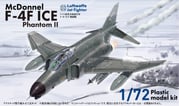aim-7 sparrow
The AIM-7 Sparrow (Air Intercept Missile) is an American, medium-range semi-active radar homing air-to-air missile operated by the United States Air Force, United States Navy, and United States Marine Corps, as well as other various air forces and navies. Sparrow and its derivatives were the West's principal beyond visual range (BVR) air-to-air missile from the late 1950s until the 1990s. It remains in service, although it is being phased out in aviation applications in favor of the more advanced AIM-120 AMRAAM.
The early Sparrow was intended primarily for use against larger targets, especially bombers and had numerous operational limitations in other uses. Against smaller targets, the need to receive a strong reflected radar signal made achieving lock-on at the missile's effective range difficult. As the launching aircraft's own radar needed to be pointed at the target throughout the engagement, this meant that in fighter-vs-fighter combat, the enemy fighter would often approach within the range of shorter-range infrared homing missiles while the launching aircraft had to continue flying towards its target. Additionally, early models were only effective against targets at roughly the same or higher altitudes, below which reflections from the ground became a problem.
A number of upgraded Sparrow designs were developed to address these issues. In the early 1970s, the RAF developed a version with an inverse monopulse seeker and improved motor known as Skyflash, while the Italian Air Force introduced the similar Aspide. Both had the ability to be fired at targets below the launching fighter ("look-down, shoot down"), were more resistant to countermeasures, and were much more accurate in the terminal phase. This basic concept was then made part of the US Sparrows in the M model (for monopulse) and some of these were later updated as the P model, the last to be produced in the US. Aspides sold to China resulted in the locally produced PL10. The Japan Self-Defense Forces also employ the Sparrow missile, though it is being phased out and replaced by the Mitsubishi AAM-4.








